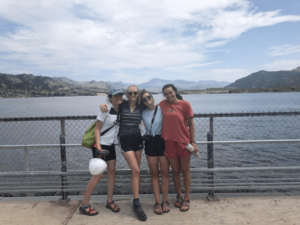
After I arrived in Augusta, MT, I received a text message from my brother who lives in Okayama, Japan. During this bike trip from Billings, MT to Glacier National Park, I didn’t have many chances to have cell service, so I couldn’t check the news of my country, Japan.
My brother told me that Japan had heavy rain recently. As a result, floods occurred in many western cities of Japan, including the town where my brother lives. Extreme weather events have also occurred in Montana. Dry and hot summers have caused severe forest fires in many places in Montana last year. Over a million acres of area in Montana burned in wildfires. Here in Augusta, heavy rain caused the Elk Creek and Sun River to flood this June.
Whenever I watch TV, I see a lot of news about extreme weather events such as floods and droughts occurring all over the world, almost every day. The report by the Intergovernmental Panel on Climate Change expects that we will experience more extreme weather events by the end of the 21th century. Of course, Montana is also included in this expectation. The Montana Climate Assessment estimated that precipitation in Montana is going to decrease in the summer and increase in the winter. Precipitation in winter is more likely to be rain than snow, and the snow runoff season will be earlier because of the increase in temperatures.
A day before we biked to Augusta, we visited Holter Dam, which is located on the Missouri River, near a town called Wolf Creek. We walked around the inside of the facility and to the top of the dam. There are four generators in the facility built in 1917. I was amazed to see old technology currently functioning. Holter Dam is the furthest downstream of three hydroelectric dams on the Missouri River that are operated by NorthWestern Energy, the largest utility company in Western Montana. Canyon Ferry Dam is the beginning and the largest reservoir of those three dams that controls the flow of the Missouri. This dam stores a large amount of spring runoff and releases water during the dry summer season. When floods or droughts are occurring, the largest of the dams controls the river flow and enables the ability to provide stable electricity generation. Moreover, Canyon Ferry Dam functions for irrigation, recreation, and helps create a better environment for trout.
When I read a brochure about Holter Dam, I thought that larger reservoirs have more potential to adapt to climate change. If the reservoir has enough storage for large amounts of water, it can store water in the rainy season to prepare for the upcoming dry season. Lake Mead is one of reservoirs of the Hoover Dam on the Colorado River, which ranks in the top 20 of the tallest dams in the world. However, because Lake Mead has low water levels from recent multi-year droughts, new turbines have been installed on the lower part of dam in case of future water shortages. Larger reservoirs are not necessarily exempt from climate change impacts. To make hydropower generation more adaptable to the water fluctuation caused by climate change, the development of new technology will become important.
During this bike trip, we visited a coal mine, a wind farm, and a hydro-power plant, the main resources of electricity in Montana. Although Montana has the largest recoverable coal reserve in the US, NorthWestern Energy generates only 22 percent of electricity from coal, 12 percent from wind power, and 44 percent from hydropower. Surprisingly, the majority of Montana’s electricity source is renewable energy, especially hydropower. However, renewable energy, such as hydropower and wind power, depend on weather conditions. Generating efficiency decreases at night, or during windless days. We cannot increase sunlight and rainfall by ourselves.
Some countries are highly dependent on hydropower generation. 70 percent of electricity in Brazil is generated by hydropower. This dependency on hydropower has caused nationwide blackouts when severe droughts have occurred. What do you think eventually happened in Brazil? They generated more electricity from coal and natural gas because they could not increase the generation of other renewable energy. I think this is ironic. Renewable energy was developed in order to mitigate climate change. But now, renewable energy is threatened by climate change, leading to more energy generation from fossil fuel and emitting more carbon dioxide.
When climate change alters the precipitation, hydropower can no longer be a reliable energy resource. If hydropower generation stops being an effective method of renewable energy due to climate change, large scale blackouts that Brazil experienced will occur and we will turn to the generation of electricity by fossil fuel. The development of technology, planning strategies, and new policies will become increasingly important in the near future.